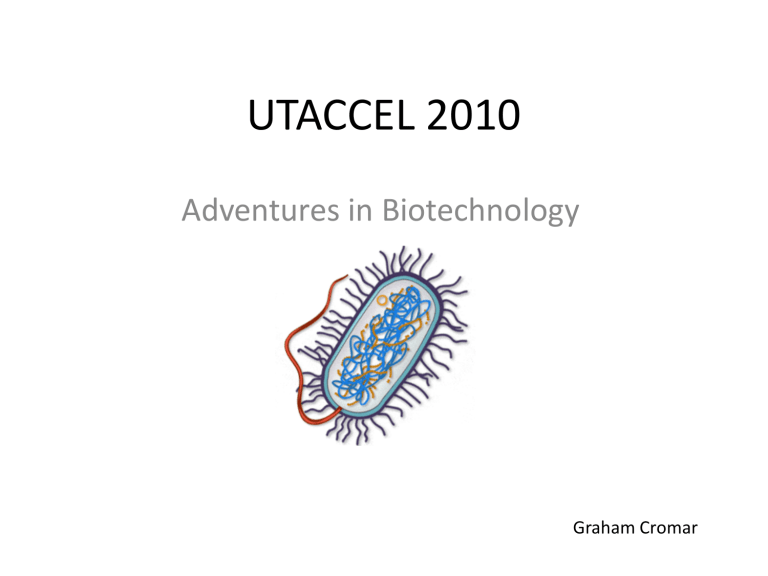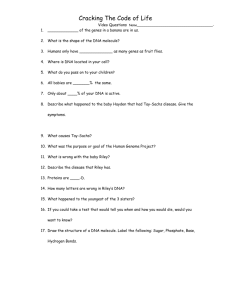Media:Toronto_UTACCEL_Genetics

UTACCEL 2010
Adventures in Biotechnology
Graham Cromar
Genetics
Inheritance
Punnett Square
Bb x Bb (Cross)
“B gene” “Big B allele” “Little b allele”
Allele = a form of a gene
Homozygous = BB, bb
Heterozygous (or hybrid) = Bb
B = purple flowers b = white flowers
1:2:1 Genotypic ratio
3:1 Phenotypic ratio
Segregation and Independent
Assortment
“True breeding”
“Hybrid”
A = Yellow, a = green
B = Round, b = wrinkled
9:3:3:1 phenotypic ratio
Genes are physically on chromosomes
Not all genes assort independently.
Genes that reside close to one another on the same chromosome separate less frequently and this alters the characteristic 9:3:3:1 ratio in predictable ways.
“Linkage”
Three Important Points to Remember
1. Chromosomes are made of DNA
2. Segments of DNA code for a protein
3. Protein in turn, relates to a trait (eye color, enzymes, hormones..)
3’
5’
“Twisted ladder” aatgccgt ttacggca
5’
3’
DNA Structure
DNA is a long double-stranded molecule residing inside the nucleus of every cell. It is usually tightly coiled forming chromosomes in which it is protected by proteins.
Each of the two strands of the DNA molecule is a chain of smaller molecules. Each link in the chain is composed of one sugar molecule, one phosphate molecule and one nucleotide molecule. There are four types of nucleotides (or 'bases') in the DNA:
adenine (A), thymine (T), guanine (G) and cytosine
(C). The two strands of DNA are structured in such a way that an adenine on one strand is always attached to a thymine on the other strand, and the guanine of one strand is always bound to cytosine on the other strand. Thus, the two strands of the DNA molecule are mirror-images of each other.
“complimentary” “anti-parallel”
Replication
“template”
A
T
T
A
C
C
C
G C
G
G
G
A
T
T
A
G
C
C
C
G
G
G C
A
T
T
A
G
C
C
C
G
G
G C
A
T
T
A
G
C
C
C
G
G
G C
C
C
C
A
T
G C
G
G
G
T
A
A
T
T
A
C
C
C
G C
G
G
G
A a a a A A
A : T
G: C
“Complimentary base pairing”
Highly recommended:
http://www.scq.ubc.ca/breakfast-of-champions-does-replication/
Aa
A A a a
Mitosis and Meiosis
Aa
Aa
A A a a
Aa
Aa Aa A A a a
Gene Expression
How are Proteins Synthesized from DNA
1. DNA is transcribed into mRNA (messenger RNA)
2. mRNA leaves the nucleus and travels to the cytoplasm
3. Ribosomes in the cytoplasm use the code on mRNA to translate it into amino acids
4. Amino acids form a chain - a protein
Transcription and Translation
“Codon”
“Anti-codon”
“Amino acid”
“Transfer RNA”
The Genetic Code
Mutations
Large scale changes occurring at the level of the chromosome also occur. These change the copy number of a gene or genes. Usually this is bad.
Model Organisms
Advantages:
• Fast generation time
• Genetically tractable
• Easy to perform crosses
• Large numbers or progeny
• Interesting features e.g. Frog morphogenesis
• Plant photosynthesis
• Representative of diverse lineages
• Similar to ourselves
(mammals)
• Extensive knowledge base
Idea:
By understanding the function of a gene in one organism, scientists can get an idea of what function that gene may perform in a more complex organism such as humans. The knowledge gained can then be applied to various fields such as medicine, biological engineering and forensics.
ABO blood groups
Blood type is controlled by a gene “i”
There are three forms: i A i B i O
Each allele makes a different antigen, a protein sitting on the surface of the red blood cell i A and i B are co-dominant i O is recessive
Quiz
1. Draw the complimentary strand to the following single-stranded DNA molecule.
5’
ATTAGGACTTAGGA
3’
2. Three new born babies have been mixed up by the nurses at the hospital. Given the blood types of the parents and babies can you match the babies to the correct set of parents?
Parents
AB x O
Babies
AB
A x B
AB x AB
B
O






